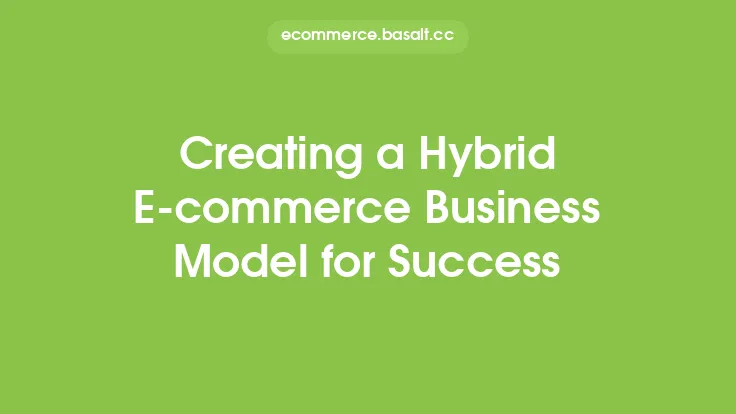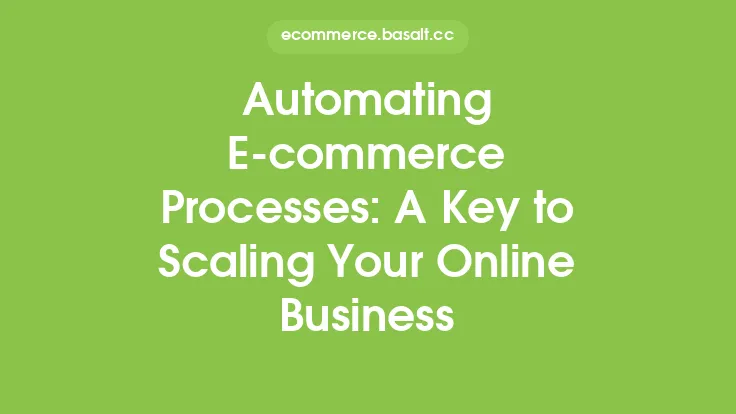When it comes to planning and executing an e-commerce business, having a clear and comprehensive strategy is crucial for success. The Business Model Canvas is a powerful tool that can help entrepreneurs and businesses alike to visualize, design, and innovate their e-commerce business models. In this article, we will delve into the world of e-commerce business models and explore how the Business Model Canvas can be used to plan and execute a successful online business.
Introduction to the Business Model Canvas
The Business Model Canvas is a strategic management template that is used to visualize and design business models. It was developed by Alexander Osterwalder and Yves Pigneur, and it consists of a single-page diagram that is divided into nine building blocks. These building blocks include customer segments, value propositions, channels, customer relationships, revenue streams, key resources, key activities, key partnerships, and cost structure. By using the Business Model Canvas, e-commerce businesses can create a clear and concise overview of their business model, identify potential weaknesses and opportunities, and develop a strategy for success.
Understanding the Building Blocks of the Business Model Canvas
To create an effective e-commerce business model using the Business Model Canvas, it is essential to understand each of the nine building blocks and how they relate to one another.
- Customer Segments: This building block refers to the specific groups of customers that the business is targeting. E-commerce businesses can have multiple customer segments, such as individual consumers, businesses, or governments.
- Value Propositions: This building block refers to the unique value that the business offers to its customers. E-commerce businesses can offer a range of value propositions, including low prices, high-quality products, convenient delivery options, and excellent customer service.
- Channels: This building block refers to the communication, sales, and distribution channels that the business uses to reach its customers. E-commerce businesses can use a range of channels, including social media, email marketing, search engine optimization, and paid advertising.
- Customer Relationships: This building block refers to the types of relationships that the business establishes with its customers. E-commerce businesses can have a range of customer relationships, including personal assistance, dedicated personal assistance, self-service, automated services, and communities.
- Revenue Streams: This building block refers to the ways in which the business generates revenue. E-commerce businesses can have a range of revenue streams, including sales, subscriptions, advertising, and data analysis.
- Key Resources: This building block refers to the essential resources that the business needs to operate. E-commerce businesses can require a range of key resources, including personnel, equipment, technology, and infrastructure.
- Key Activities: This building block refers to the main activities that the business needs to perform to deliver its value proposition. E-commerce businesses can have a range of key activities, including supply chain management, marketing, sales, and customer service.
- Key Partnerships: This building block refers to the strategic partnerships that the business establishes with other organizations. E-commerce businesses can have a range of key partnerships, including suppliers, logistics providers, and technology partners.
- Cost Structure: This building block refers to the main costs that the business incurs to operate. E-commerce businesses can have a range of costs, including personnel costs, equipment costs, technology costs, and marketing costs.
Applying the Business Model Canvas to E-commerce
By using the Business Model Canvas, e-commerce businesses can create a clear and comprehensive strategy for success. Here are some steps that e-commerce businesses can follow to apply the Business Model Canvas:
- Identify the target customer segments and create buyer personas to guide marketing and sales efforts.
- Develop a unique value proposition that differentiates the business from its competitors.
- Choose the most effective channels to reach the target customer segments and deliver the value proposition.
- Establish strong customer relationships through excellent customer service and support.
- Develop a range of revenue streams to reduce dependence on a single source of income.
- Identify the key resources that are required to operate the business and ensure that they are in place.
- Perform the key activities that are necessary to deliver the value proposition and achieve the business goals.
- Establish strategic partnerships with other organizations to reduce costs, improve efficiency, and increase revenue.
- Manage the cost structure to ensure that the business is profitable and sustainable.
Benefits of Using the Business Model Canvas for E-commerce
There are several benefits of using the Business Model Canvas for e-commerce businesses, including:
- Improved clarity and understanding of the business model
- Enhanced ability to identify and mitigate risks
- Increased agility and adaptability in response to changing market conditions
- Better alignment of the business strategy with the company's mission and vision
- Improved communication and collaboration among team members and stakeholders
- Enhanced ability to innovate and disrupt the market
- Increased focus on customer needs and preferences
- Improved revenue and profitability
Common Mistakes to Avoid When Using the Business Model Canvas for E-commerce
While the Business Model Canvas is a powerful tool for e-commerce businesses, there are several common mistakes that can be made when using it, including:
- Failing to regularly review and update the business model canvas
- Not involving all relevant stakeholders in the business model design process
- Focusing too much on the technology and infrastructure, and not enough on the customer needs and preferences
- Not prioritizing the key activities and resources that are necessary to deliver the value proposition
- Not establishing strong partnerships with other organizations
- Not managing the cost structure effectively
- Not continuously monitoring and evaluating the business model
Best Practices for Using the Business Model Canvas for E-commerce
To get the most out of the Business Model Canvas, e-commerce businesses should follow best practices, including:
- Regularly reviewing and updating the business model canvas to reflect changing market conditions and customer needs
- Involving all relevant stakeholders in the business model design process
- Focusing on the customer needs and preferences, and designing the business model around them
- Prioritizing the key activities and resources that are necessary to deliver the value proposition
- Establishing strong partnerships with other organizations
- Managing the cost structure effectively
- Continuously monitoring and evaluating the business model
- Using the business model canvas to identify opportunities for innovation and disruption
Conclusion
In conclusion, the Business Model Canvas is a powerful tool that can help e-commerce businesses to plan and execute a successful online business. By understanding the nine building blocks of the Business Model Canvas and applying them to the e-commerce business, entrepreneurs and businesses can create a clear and comprehensive strategy for success. By following best practices and avoiding common mistakes, e-commerce businesses can use the Business Model Canvas to improve their clarity and understanding of the business model, enhance their ability to identify and mitigate risks, and increase their agility and adaptability in response to changing market conditions.





